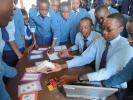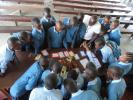Simple Strategies: An Interview with Brendan Lawlor of the Boys and Girls Club
In June 2011, ScratchEd spoke with Brendan Lawlor to learn more about his work with Scratch at the Boys and Girls Club in Nantucket, MA. Since that interview, Brendan has moved to Arusha, Tanzania, East Africa to take up a position as the Information and Communication Technology Teacher Mentor at an NGO school, where he currently helps teachers integrate Scratch into their secondary level curriculum. Brendan also introduces Scratch to students who attend his afterschool Media Arts Club. The following story reflects strategies and approaches that Brendan developed during his position at the Nantucket Boys & Girls Club.
Serving ages six through eighteen, the Nantucket Boys & Girls Club offers an afterschool program for elementary, middle, and high school students. With an independently created degree, combining computer science and graphic design, Brendan Lawlor facilitates computer lab activities as the Computer Coordinator at the Club. While Brendan discovered Scratch as a way to combine his love of design with his technical know-how, his primary motivation is to give kids “a way to learn to use the computer in an expressive way rather than a passive way.”
In an informal, afterschool program, the biggest obstacle Brendan deals with is continuity. Club members are allowed to roam through the various activity rooms, so Brendan’s Scratch class has a drop-in feel. “One of the huge constraints of working at the Boys and Girls Club is that it’s not really a class situation. Kids can come and go as they please and consistency is a big issue.” The continuous circulation of students means that the only thing that Brendan can count on maintaining is constant variety. His challenge is two-fold: how to get new students started with Scratch while at the same time support continuing students to extend previous work. He confesses that it can be challenging to keep a consistent curriculum. “I always come up with a demonstration project to show them each time to show something new, but it’s hard to have a curriculum. I often have kids who’ve been doing it since September mixed in with kids who’ve never seen the program before.”
Brendan must continually adjusts his activities and approaches to fit the every-changing needs of the students, but despite the varied learning environment, he has developed strategies over time that have persisted in his pedagogy.
His biggest piece of advice? “Keep it simple.”
Simplicity itself is what helps Brendan facilitate Scratch in this setting. To begin, Brendan addresses the time constraint by keeping his Scratch introductions short, sweet, and tied to students’ personal interests. “Most of the kids are interested in making video games, so that’s how I got a lot of them interested and started on the program. The fact that they can make a game, that’s a huge draw. They look up to online games that they play and they really want to be able to make them themselves, so I like that Scratch is blurring the boundary between playing a game and doing something more creative and less passive.”
Brendan has also developed accessible ways for the kids to dive into Scratch without flooding them with too much instruction. “Initially, I made a couple demonstration programs to show a simple way to use the arrow keys or the mouse as inputs to control your character. I just show what blocks I used as a starting point, and if they want to recreate that, I can help them remember how to put the pieces together. I generally try to keep it really simple and not to use too many things to overwhelm them.”
To help students scope their projects appropriately for the short amount of time they have, Brendan has another simple strategy. He advises students to write out ideas on paper to plan and keep track of their progress. “I encourage them to sketch out their ideas on paper first and get an idea of what they want to have happen, and then I go around and help them figure out what blocks they need to make it happen. When I was learning computer science, it helped me to get things down on paper so that developed into a teaching strategy that I like to use.”
This suggestion enables Brendan to have one-on-one time with each student. “It helps me to quickly understand what they want to do too.” By clearly expressing their goals on paper first, Brendan can efficiently gather students’ intentions rather than attempting to decipher jumbled code. “This especially helps with simplifying video game projects. They usually snap together a bunch of code and I can’t figure out what they want to do and some are really elaborate so writing it out in English helps simplify it. I just ask them, ‘Think about what you want to have happen and express that in words if you can.’ I want them to use their own ideas and come up with making something their own as much as possible. That’s why I like using Scratch. I think it challenges you to think in different ways and that’s the coolest thing.”




Thank you, the interview was helpful for me and trying to put together an after-school program.
Hi Maria,
I'm so glad to hear that the story was helpful to you! Please let us know how the after-school program planning goes.
Sincerely,
Michelle on behalf of the ScratchEd Team